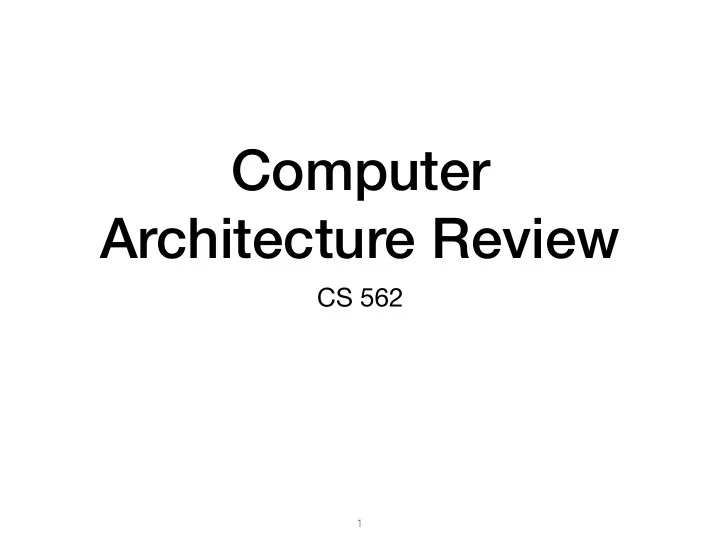

Computer Architecture Review CS 562 � 1
The von Neumann Model John von Neumann (1946) proposed that a fundamental model of a computer should include 5 primary components : • Memory • Processing Unit • Input Device(s) • Output Device(s) • Control Unit � 2
Memory • For our purposes, an array of bytes. We will not be dealing with virtual memory (yet) • Recall: When we talk about memory, addressability refers to the size of a memory location (the thing that goes in and comes out of memory) • Recall : When we talk about address width , we mean how many bits are required to represent an address • Ex: recent x86-64 machines have 64-bit address width and are byte addressable � 3
Memory Cont. • How do we access? • Loads and Stores • Accomplished with the help of memory unit (MMU) on the CPU. Simplest scheme has two registers: • MAR : memory address register (address from which to load, to which to store) • MDR : memory data register (stu ff to store) � 4
Processing Unit • Can consist of many separate functional units (integer arithmetic, floating point, vector units, DSP , etc. etc.) • Simplest one is the ALU (arithmetic logic unit) • Size of data worked on by ALU is the CPU’s word length • Today we call this the datapath of the processor � 5
Proc. Unit. contd. • Temp. Storage: most commonly registers (these are fast access, close to functional units) • May also be stack (more on this later) � 6
I/O • The peripherals attached to the machine: • keyboard, mouse, video card, monitor, disk, etc. etc. • Two methods of I/O: polling (CPU busy waits until something is read) or interrupt-driven (device raises a wire hot to notify CPU) • You will become very familiar with the latter � 7
Control Unit • Keeps track of where we are in the program, where to go next • Where we are: Instruction Register (IR) . Register which holds the currently executing instruction • Where to go next: Instruction Pointer (IP). Memory address of next instruction to execute. (Also called program counter or PC). • Finite State Machine: Given current inputs and current instruction, where do we go next? Essentially implemented as a lookup table. You will implement as logic in C. ?? Isn’t it always just IP + 1? • Controls signals to the datapath (e.g. which arithmetic op should ALU perform, what is the sequence of operations of the various regs?) � 8
� 9
ISAs • Instruction Set Architecture • The interface to the hardware from the programmer’s point of view • Also, the boundary between software and hardware � 10
Classes of ISAs • Load-Store machines : Can access memory *only* with explicit load or store operations (e.g. MIPS, RISC-V, ARM, PowerPC, SPARC, LC-3) • Register-Memory machines : Can access memory in other types of operations as well (e.g. x86) • addl $0x7, 8(%rax) • Stack Machines : All operations are performed via a LIFO stack (e.g. JVM, WebASM, Forth, PostScript, ) � 11
The Instruction Cycle • For our purposes, instruction dispatch will essentially occur in three stages: • Fetch • Decode • Execute • Real hardware involves (in some cases many) more stages � 12
Let’s design a simple ISA • Assume 16-bit address width and addressability • That means 2^16 mem locations, 65K (just like the 6502) • Assume 8 General-purpose registers (GPRs) • OK, what does our instruction set look like? � 13
Things we had to consider • Instruction length (variable/fixed?) and encoding • Operand encoding/size • Memory addressing modes (immediate, PC-relative, base-index, maybe SID) • Operations we support (arithmetic, logical, control flow) • Supporting conditional operations � 14
Memory Mapped I/O • Instead of using processor pins for I/O devices, just have devices respond to special regions of memory addresses • Old machines had hardcoded regions. These days the regions are programmable, e.g. with the PCI, PCIe device standard specification • Ex: LD R1, $0xa700 • Ex: ST R2, $0xa720 � 15
simple memory controller logic word_t read(addr) { if (addr >= 0xa700 && addr < 0xb700) { return my_device_read(addr); } else { return ram_read(addr); } } � 16
Recommend
More recommend